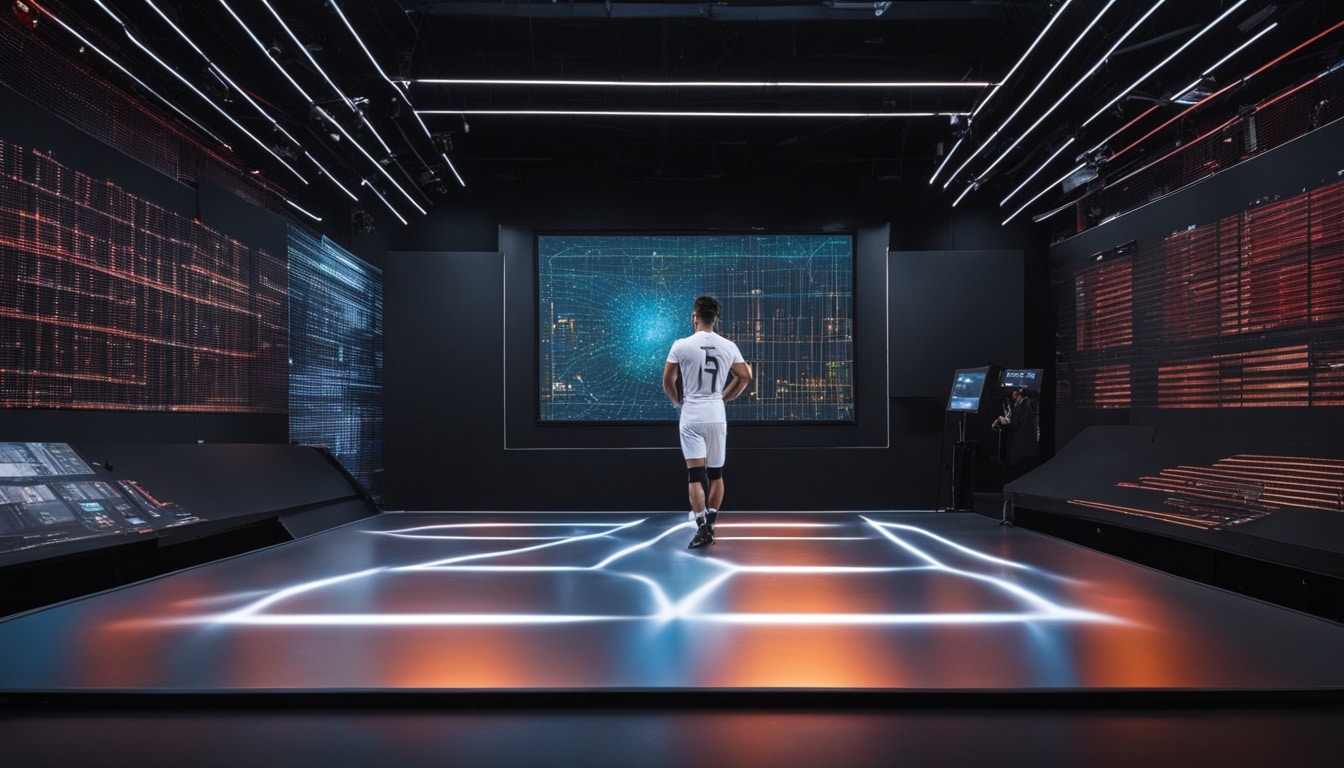Sports Technology: artificial intelligence has recently advanced significantly. It’s now applied in many fields, including sports. Through AI, the sports industry is undergoing big changes. These changes are making athlete training more competitive and effective. AI is also being used to evaluate and foresee athletes’ performance. By 2030, the AI sector in sports is expected to hit a whopping 19.2 billion dollars.
Key Takeaways
- Artificial intelligence is revolutionizing the sports technology landscape.
- AI is enhancing athlete training, performance analysis, and injury prevention.
- The AI segment in the sports industry is projected to reach $19.2 billion by 2030.
- AI-powered solutions are transforming fan engagement and stadium experiences.
- Sports equipment companies are leveraging AI to create personalized, high-performance gear.
AI in Sports Industry: An Overview
The sports world is changing a lot because of AI. This technology is used from making players better to how we, the fans, interact with the sport. The ways AI can be used in sports keep growing.
Potential Applications of AI in Sports
AI is big news in sports because it can handle huge amounts of data. It studies everything from player stats to videos and how fans join in. By finding patterns in this info, teams can get better, make smarter choices, and understand their games more.
AI also helps make a virtual world for athletes to train. This means players can practice game situations and improve their skills in a safe, controlled way.
AI Segment Growth in Sports Industry
The use of AI in sports is picking up speed fast. Experts say the AI sector in sports could be worth $19.2 billion by 2030. This shows how much teams and organizations see the value in using AI to boost their work.
Going forward, more and more sports groups will look for AI solutions to help step up their game.
Harnessing AI for Advanced Player Performance Predictive Models
The use of predictive modeling with AI changes how we see sports analytics and player performance. It helps teams predict injuries or performance slumps. This lets coaches plan player rotations and strategies better.
Forecasting Player Injuries and Slumps
AI makes predictive models by reviewing lots of data using machine learning. It looks at things like player stats, injury history, and disciplinary records. From this, AI can make models that guess how players will do in the future. This helps teams see and fix possible injuries and performance issues ahead of time.
Identifying Breakout Performers
Furthermore, AI-powered predictive analytics are good at finding breakout performers. It looks at many things, like player records and strengths, to see who has the potential to stand out. This knowledge lets teams support rising stars and do better in the sports industry.
Leveraging AI to Decipher Game Footage and Detect Patterns
AI is great at studying game footage. It unveils hidden patterns and trends we might miss. This new knowledge helps teams make smarter strategic decisions in sports, giving them an edge.
AI uses machine learning to dig deep into game footage. It focuses on players or things in the game. This detailed look helps us understand pattern detection in sports and how the game flows.
In-Game Strategic Decisions
AI game footage analysis offers big insights for teams. It shows patterns in how players move, where the ball goes, and how teams set up. Coaches can change strategies as they play, beating their opponents. This gives them the edge to win.
Player Performance Evaluation
AI is also key in evaluating player performance. It looks at each player’s role closely. Thanks to sports analytics, teams know who’s doing great and where others need to improve. This helps coaches better spend their time, improving training and player skills.
Crafting Tailored Training Regimes with AI

Today’s top athletes are using AI in athlete training. They’re making their training plans better. AI helps create individualized training regimes. These are made just for the athlete’s needs. AI also keeps an eye on progress in real time. This gives exact feedback to improve the training.
AI for enhancing athletic performance brings big benefits. It boosts performance, lowers injury risk, and speeds up recovery. Personalized training with AI is not just a phase. It’s changing the game in how athletes do better and stay well.
| Key Benefits of AI-Powered Training | Impact on Athletic Performance |
|---|---|
| Personalized Training Regimes | Enhanced Performance |
| Real-Time Progress Monitoring | Reduced Injury Risk |
| Precise Performance Feedback | Speedy Recovery |
“The use of technology in sports training has changed everything. AI solutions are leading the way. They help athletes reach new peaks of success and health.”
AI: The Game Changer in Sports Equipment Innovation

Sports companies are turning to AI for next-level gear. Big names like Adidas and Wilson lead the way. They use AI to make super advanced sporting goods.
Personalized Sports Gear
Thanks to AI, sports gear is now super precise and fits each athlete perfectly. This new trend is changing how athletes train, pushing performance to new levels. Adidas, for example, created an AI soccer ball. It changes its path in the air to match how each player likes to kick.
AI in Mainstream and Niche Sports Equipment
AI isn’t just for popular sports; it’s also changing gear for less common activities. Wilson has designed a tennis racket that uses AI. It helps players hit the ball harder and more accurately. By checking their swing and position, it gives tips in real-time to improve their game.
The use of AI in sports equipment, AI-powered sports gear, and personalized sports equipment is revolutionizing games. As AI in mainstream and niche sports equipment gets better, all athletes, pro or not, will see improvements from these technology in sports products.
Leveraging AI to Elevate Fan Experiences

Sports teams worldwide are using AI for fan engagement to make the fan experience better. From AI-powered fan experiences to personalized content, AI changes how fans connect with teams.
Immersive VR Experiences
The Golden State Warriors use AI in sports entertainment for amazing virtual reality. Fans feel like they’re on the court, experiencing the game’s excitement live. This is all thanks to the high-tech immersive VR in sports.
Personalized Content and Interaction
The Los Angeles Dodgers have also embraced AI to engage fans better. They use AI to create personalized content for sports fans, offering custom news and chances to interact with players. This makes the fan experience more personal and exciting.
Smart Stadium Technologies
AI’s influence goes beyond digital fun to the physical world. Stadiums are turning into smart stadium technologies, using AI to enhance everything from getting around to buying tickets. These smart stadium technologies make the fan journey smoother, letting them enjoy the game and team more.
AI for Injury Prevention and Enhanced Player Safety
In sports, injuries are not just physical setbacks. They can also lead to hefty financial costs. This includes paying a player who can’t play, lost earnings from games, and the risk to a team’s dreams. Many teams now rely on AI to watch over player health. This helps stop injuries before they happen. AI for sports injury prevention and AI for player safety are now key in sports.
Monitoring Player Fatigue and Health
The Chicago Cubs use AI-powered player monitoring to watch how tired their players are. The Cleveland Indians do a similar thing with AI to check on how players sleep. These systems point out players who might get hurt. Then, teams can tweak training and habits to keep injuries at bay.
Injury Risk Assessment Models
AI goes further than watching players every moment. It runs deep into player data to predict who might get injured next. This way, sports teams can jump in before the shock hits. They do things to keep their players safe and sound. The use of AI in sports medicine is changing how we think about keeping athletes off the bench.
AI For Predicting Player Performance And Injury Prevention

AI for predicting player performance is a big deal in sports like baseball where it’s used a lot. Tools such as Statcast go over tons of player data. This includes things like player movements and how fast balls are thrown. It gives helpful tips to players, coaches, and fans.
But AI does more than just predict outcomes. It also helps prevent injuries. For example, Sparta Science uses AI to check how players move very closely. By collecting lots of data points, it creates a “Movement Signature” for each player. This helps teams make better training plans and keep players safe.
AI is changing how teams take care of their players, too. It looks at details like how tired players are and when they sleep. This way, it can spot who might get injured before it happens. This helps stop players from getting hurt and saves teams a lot of money. It keeps the players on the field, and the fans happy.
Also Read: How Can I Improve My Physical Health?
| Key AI Applications in Sports | Outcomes |
|---|---|
| Player Performance Prediction | Comprehensive data analysis, enhanced coaching strategies, personalized player development |
| Injury Risk Assessment and Prevention | Proactive injury mitigation, improved player safety, reduced financial burden |
| Training Regime Optimization | Personalized workout plans, enhanced athletic performance, reduced injury likelihood |
| Fan Engagement and Experience | Immersive virtual reality, personalized content, smart stadium technologies |
AI For Improving Sports Technology
The mix of AI and sports is making big changes. It’s changing how players train and how equipment gets made. It’s also making how fans connect with their teams better. AI is leading a new wave in sports, focused on improving performance, personalizing gear, and making sports more fun.
Big names in sports gear, like Adidas and Wilson, are using AI to make better stuff. Adidas made an AI soccer ball that changes its flight to hit goals more precisely. Wilson made a tennis racket that helps players hit the ball harder and more accurately with AI. This tech makes gear smarter and fits the specific needs of athletes. It changes how sports equipment works, making players better than ever.
AI isn’t just about gear. It’s also helping teams and players stay healthy. AI can predict when a player might get hurt so coaches can keep them safe. It’s also making sports events cooler for fans. With AI, stadiums can offer VR, personalized content, and easy ways to get around. As AI in sports grows, it will make big strides in innovation. It will give athletes, teams, and fans amazing new experiences.
FAQs
Q: How is artificial intelligence being used in sports technology?
A: Artificial intelligence is being used in sports technology to analyze player performance, predict outcomes, and enhance coaching strategies. AI is also used to improve fan engagement and create more interactive experiences.
Q: What role do sensors play in sports technology?
A: Sensors play a crucial role in sports technology by capturing data on athletes’ movements, performance metrics, and health indicators. This data is then used to optimize training programs, prevent injuries, and track progress.
Q: How is virtual reality technology changing the sports landscape?
A: Virtual reality technology is revolutionizing the world of sports by providing immersive training simulations for athletes, offering fans a more engaging viewing experience, and creating new revenue streams for sports organizations.
Q: What are some popular sports tech companies leading innovation in the industry?
A: Some popular sports tech companies that are leading innovation in the industry include Nike, Adidas, Catapult Sports, and Zebra Technologies. These companies develop cutting-edge solutions for wearable sports technology, sensor technologies, and fan engagement platforms.
Q: How has technology become an integral part of the sports industry?
A: Technology has become an integral part of the sports industry by enhancing performance analysis, improving training methods, increasing fan engagement through digital platforms, and optimizing operations for sports organizations.
Q: What is the impact of goal line technology on sports leagues?
A: Goal line technology has revolutionized sports leagues by providing more accurate and fair decisions during crucial moments in matches. It has helped reduce controversies and ensured the integrity of the game.
Q: How are wearable sports technologies shaping the future of sports?
A: Wearable sports technologies are shaping the future of sports by providing real-time performance data, enhancing training efficiency, and improving injury prevention strategies. Athletes and coaches can use wearable devices to optimize performance and track progress.





